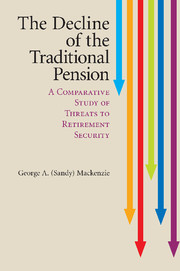Introduction
Published online by Cambridge University Press: 05 June 2012
Summary
Traditional Pensions in Trouble
The defined-benefit plan has been the preeminent pension form for over a century. Virtually all of the national pensions of industrial countries are defined-benefit plans, as are many of the national pensions in developing and emerging-market countries. It remains the dominant second-tier plan for public-sector employees (i.e., civil servants, teachers, and other occupations working for governments at any level, and employees of public-sector enterprises and decentralized public agencies). Similarly, until recently it has been the dominant form in the private sector of those countries where the second tier covers a significant share of the workforce. Employer-provided defined-benefit plans are invariably average- or final-salary plans.
The labor force coverage of employer-provided plans varies greatly from one country to another, mainly because of variations in the coverage of private-sector employees. In some advanced economies, and notably in France and Italy, coverage is low. However, in a group of ten advanced countries that includes five G-7 members (the United States, Canada, Germany, the United Kingdom, and Japan), as well as Australia, the Netherlands, Denmark, Sweden, and Switzerland, employer-provided pensions cover a significant share of the labor force. The absolute number of employees covered by public- and private-sector plans in these countries is large, and private-sector plan assets amount to about 70 percent of the group's GDP (Table I.1). The book's analysis of developments in employer-provided pensions concentrates on these ten countries.
- Type
- Chapter
- Information
- The Decline of the Traditional PensionA Comparative Study of Threats to Retirement Security, pp. 1 - 12Publisher: Cambridge University PressPrint publication year: 2010



